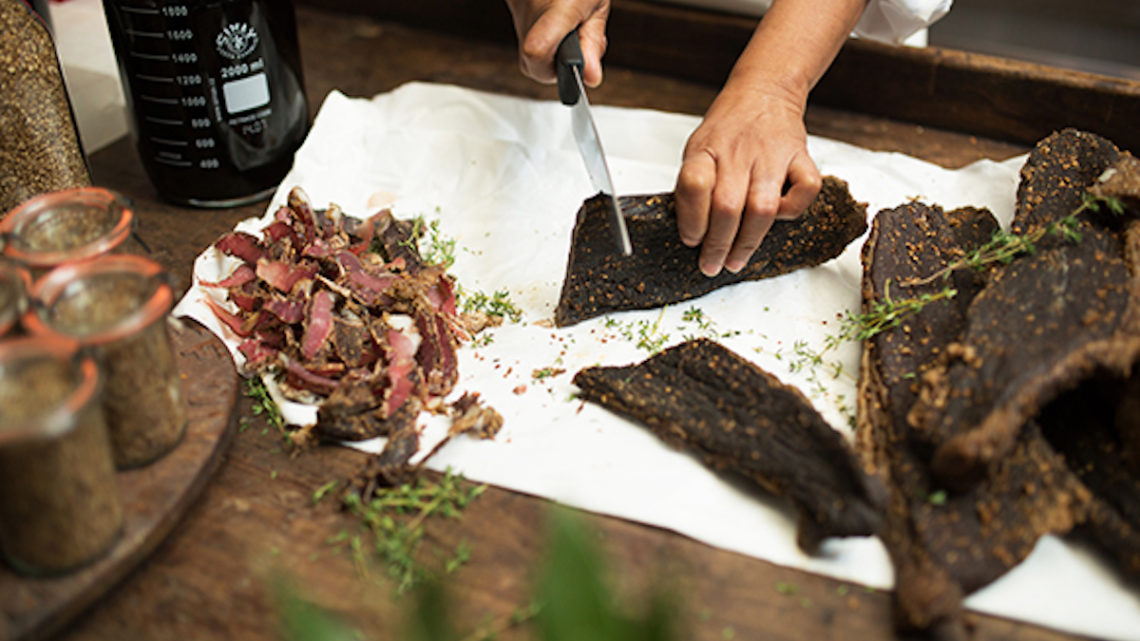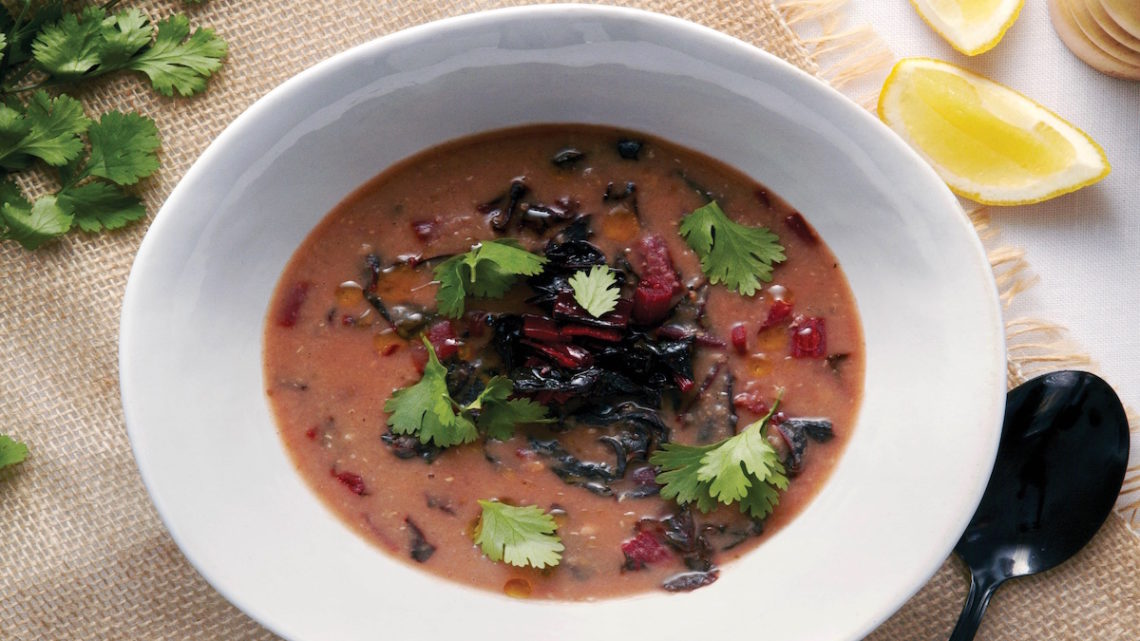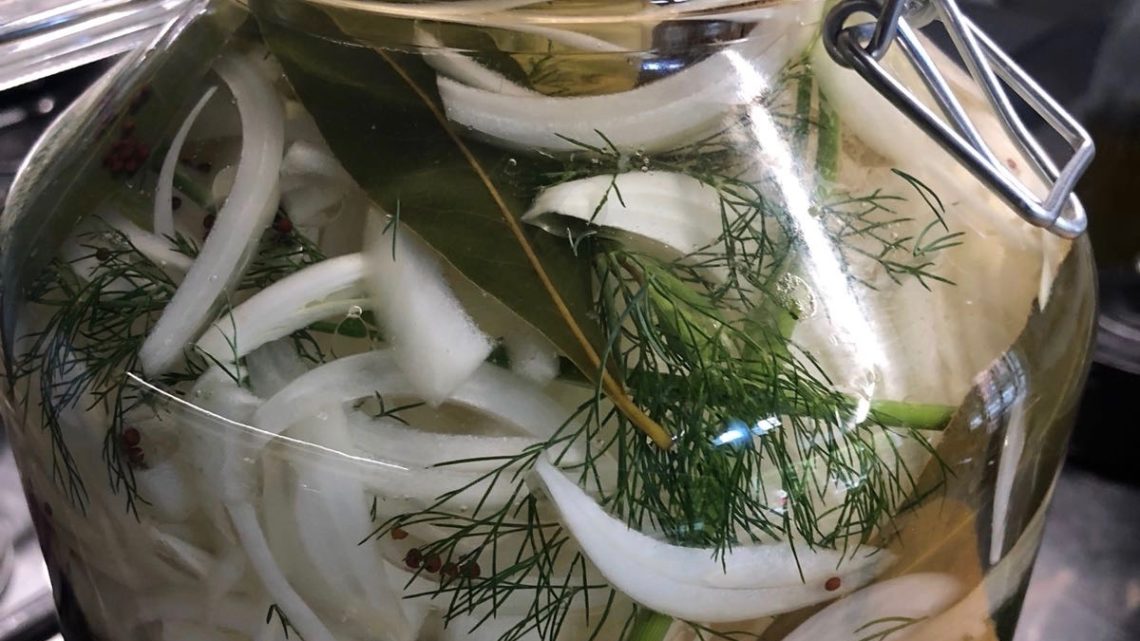Biltong
Biltong is a form of dried, cured meat that originated in Southern African countries (South Africa, Zimbabwe and Zambia). Various types of meat are used to produce it, ranging from beef and game meats to fillets of meat cut into strips following the grain of the muscle, or flat pieces sliced across the grain. It is related to beef jerky in that they are both spiced, dried meats; however, the typical ingredients, taste and production processes may differ.
The word biltong is from the Dutch bil ("buttock”") and tong ("strip" or "tongue").
Meat preservation as a survival technique dates back to ancient times. Indigenous peoples of Southern Africa, such as the Khoikhoi, preserved meat by slicing it into strips, curing it with salt, and hanging it up to dry. European seafarers preserved meat for their long journeys by curing meat in salt or brine. European settlers (Dutch, German, French) who arrived in southern Africa in the early 17th century used vinegar in the curing process, as well as saltpetre (potassium nitrate). The potassium nitrate in saltpeter kills Clostridium botulinum, the deadly bacterium that causes botulism while the acidity of the vinegar inhibits its growth. According to the World Health Organization, C. botulinum will not grow in acidic conditions (pH less than 4.6), therefore the toxin will not be formed in acidic foods. The antimicrobial properties of certain spices have also been drawn upon since ancient times. The spices introduced to biltong by the Dutch include pepper, coriander, and cloves.
The need for food preservation in South Africa was pressing. Building up herds of livestock took a long time, but with game in abundance in South Africa, traditional methods were called upon to preserve the meat of large African animals such as the eland in a warm climate. Iceboxes and refrigerators had not been invented yet. Biltong as it is today evolved from the dried meat carried by the wagon-travelling Voortrekkers, who needed stocks of durable food as they migrated from the Cape Colony north and north-eastward (away from British rule) into the interior of Southern Africa during the Great Trek. The meat was preserved and hung to be dried for a fortnight during the colder winter, with the cold temperatures aiding to further inhibit bacterial and fungal growth. Once suitably dried, the biltong was ready for packing in cloth bags, which allow air circulation to prevent mould.
While biltong is usually eaten as a snack, it can also be diced up into stews, or added to muffins or pot bread. Biltong-flavoured potato crisps have also been produced, and there are cheese spreads with biltong flavour. Finely shredded biltong is eaten on slices of bread and in sandwiches.
Biltong can be used as a teething aid for babies.
Biltong is a high-protein food.
Marshmallow with raspberries
Ingredients
2 egg whites
12 leaves gelatine
pinch of salt
500 g castor sugar
350 ml water
1 tablespoon flavourings rose water
1 punnet fresh raspberries
Method
Put the sugar and water in a pan and boil until they reach 127 C. Begin to beat the egg whites in an electric mixer when the sugar is at 121C. Soften the gelatine leaves is water and then dissolve the gelatine in the hot syrup.
Pour the syrup slowly on to the whisked egg whites and add the rosewater. Let it whisk until cold and working quickly, pour half the marshmallow mixture into a tin or container dusted with a mixture of equal quantities of cornstarch and icing sugar. Lay the raspberries on top and cover with the remaining marshmallow mixture. Let it cool completely and then cut into cubes. Dust with the cornstarch/sugar mixture and serve. Store, refrigerated, in an airtight container.
Traditional Oliebollen
An oliebol is a traditional Dutch food. They are called oliebollen (literally oil spheres) in the Netherlands. In English they are more commonly known as Dutch Doughnuts or Dutchies.
Oliebollen are a variety of dumpling made by using an ice-scooper or two spoons to scoop a certain amount of dough and dropping the dough into a deep fryer filled with hot oil. In this way, a sphere-shaped oliebol emerges. Oliebollen are traditionally eaten on New Year's Eve and at funfairs. In wintertime, they are also sold in the street at mobile stalls.
Makes about 25
Ingredients
125 g golden raisins
75 g currants
50 g butter
500 ml buttermilk
10 g dried yeast
2 Tablespoons sugar
500 g flour
1 egg
1 teaspoon salt
1 litre sunflower oil
cinnamon-sugar or icing sugar for dusting
Method
Place the dried fruit in a bowl and pour over 300 ml boiling water. Allow the fruit to swell up for 15 minutes, then pour off the water.
In the meantime, gently heat the buttermilk and butter in a saucepan over low heat until lukewarm. Place the yeast and sugar in a bowl and stir in the warmed buttermilk.
Place the flour and salt in a bowl and make a well in the centre. Beat the egg in a small bowl. Add the yeast mixture and beaten egg to the flour and mix to a thick batter.
Roughly chop the fruit and add to the batter and mix well. Cover the bowl with a damp tea towel and leave in a warm place to rise for about 1 hour.
Heat the oil in a large pan or deep fryer to 180 C. Dip an ice cream scoop or 2 tablespoons in the oil to prevent the batter from sticking and drop the spoonfuls in the oil. Fry for about 6 minutes until golden brown and cooked through.
Drain the oliebollen on kitchen paper and roll in cinnamon sugar or dust with icing sugar. Serve with a glass of champagne or sparkling wine and toast the new year in.
We, the Amsterdam Flavours chefs, hope you enjoy this recipe as much as we do. If you have any questions on how to prepare it or just want to send us your feedback, you can reach us here Contact Amsterdam Flavours
Pheasant with Creamy Brussel Sprouts, Chestnuts and Bacon
With just a few more weeks to go until Christmas, it's time to find ideas of what to serve. This is a delicious main course using pheasant, a great change from the traditional turkey or ham. This dish is also quick and simple to prepare and won't require hours of slaving in the kitchen.
Serves 2
Ingredients
3 pheasant breasts
100 gr pack vacuum packed chestnuts
100 gr lardons
250 gr Brussel sprouts
125 ml tub cream
20 gr cube butter
3 tablespoons olive oil
75 ml red wine
75 ml port
salt
pepper
Method
Bring a pot of salted water to the boil. Add the Brussel sprouts to the pot and cook for 2 minutes. Transfer the sprouts to a bowl of cold water to stop the cooking.
Heat a frying pan over medium heat with 1 tablespoon olive oil and fry the lardons until golden brown. Check the pheasant breasts for any shot (little pieces of bullet).
Add the chestnuts and Brussel sprouts and fry for 1 minute. Add the cream, salt and pepper and leave over a low heat.
Season the pheasant breasts with salt and pepper. Heat a frying pan over medium heat with 2 tablespoons olive oil. Lay the pheasant, skin-side down in the pan and fry for 2 minutes. Turn over and fry for a further 1 minute (the pheasant breasts should still be pink inside).
Remove the pheasant from the pan and set aside. Deglaze the pan with 75 ml red wine and 75 ml port and reduce until the sauce becomes thicker. Stir 1 cube butter through. Slice the pheasant breasts diagonally. Spoon the creamy Brussel sprouts and chestnuts in the middle of 2 plates. Lay the pheasant on top and spoon over the sauce.
Menno Kroon
We're approaching the end of the November and Christmas is just around the corner. You're probably all starting to think about your decorations for the festive season.
One of our favourite florists in Amsterdam, Menno Kroon is getting us in to the festive mood with the gorgeous flowers and decorations.
Go an have a look for yourselves and get inspired.
Red Lentil and Swiss Chard Soup
Keep the cold at bay with this warm and comforting soup which is also happens to be incredibly healthy.
Serves 2
Ingredients
200 g red split lentils
1 vegetable stock cube
1 red onion
200 g swiss chard
1 teaspoon ground cumin, 1/2 teaspoon ground coriander
2 garlic cloves
1 lemon
1 bag coriander
4 tablespoons olive oil
salt and freshly ground black pepper
Method
Finely chop the onion and garlic. Dissolve the stock cube in 1 litre hot water.
Heat a pot over medium heat with 2 tablespoons olive oil. Sweat the red onion for 2 minutes. Add the chopped garlic and fry for a further 1 minute.
Add the spices, lentils and stock to the pot. Bring to the boil and simmer for 10 – 15 minutes. If necessary, remove the froth with a soup ladle.
Slice the stalks away from the leaves of the swiss chard. Wash the chard and drain in a colander. Finely slice the leaves and slice the stalks on the diagonal into 1 cm pieces. Heat a frying pan with 2 tablespoons olive oil and fry the chard stalks for 4 minutes, add the leaves and cook for a further 2 minutes.
Blend the cooked lentils with a stick blender to a coarse soup. Season with salt and pepper.
Add the fried chard to the lentil soup and add lemon juice to taste. Pick the coriander leaves. Divide the soup between 2 bowls and garnish with the coriander.
Polaberry
Polaberry, a new store in Amsterdam combines artistic creation using berries and Belgian chocolate. These are truly edible gifts combining strawberries, fruit and flowers.
It's the prefect gift to surprise a friend of loved one, or just for the sake of giving someone a gift. Who doesn't love berries and chocolate?
Fo more information, visit Polaberry.
Pompadour
Pompadour in Amsterdam's 9 straatjes (9 streets) is one of our favourite pastry stores.
They work with the season's best products to produce irresistible creations. The array on offer extends from tarts, to meringues and the most perfect chocolate truffles.
As chefs, the most important thing to us besides how beautiful things are is the flavours. Pompadour manages to maintain the perfect balance. The pastries are never too sweet, so that the flavour of the core ingredient is accentuated.
We suggest you either go and spoil yourself in their classic tearoom or take one of the pastries away to enjoy at home.
Visit Pompadour for more information.
Guus Meeuwis en Dick Middelweerd - The Book Launch
What do you get when you put a famous Dutch singer and a 2 Michelin star chef together? Answer is a cooking book full of delicious recipes to recreate at home.
The two launched their second cook book together at Amsterdam Flavours with a lunch they prepared for the press. There was hustle and excitement in the kitchen as they plated up and served their multi-course lunch of dishes from the book.
The book is categorised into important events or holidays during the year ranging from simple to more technical recipes.
Preserved Tomatoes
A great way of preserving tomatoes when they are at their best during the summer months. Use them during the winter in pasta sauces, on cheese sandwiches or in a tomato salsa.
Ingredients
2 litres water
60 gr caster sugar
30 gr salt
4 bay leaves
5 cloves
1 tablespoon mustard seeds
130 ml white wine vinegar
2 tablespoons sunflower oil
1 kg firm ripe tomatoes, cut into pieces
10 sprigs dill, roughly chopped
100 g celery, roughly chopped
6 cloves garlic, peeled
2 onions, finely sliced
Method
Bring a large pan with the water, sugar, salt, bay leaves, cloves and mustard seeds to the boil. Once the water has boiled, turn off the heat and allow the water to cool so that all the flavours are released.
Once it's completely cooled, add the vinegar and mix well. Pour the sunflower oil into a 2 liter preserving jar. Place the tomato, dill, celery and garlic in the jar. Add the onions last, so that they are on top. Pour over the cooled liquid, close the lid and place the jar in a warm place (25 C) for 10 days.
The tomatoes, if well sealed, can keep for up to 6 months.






